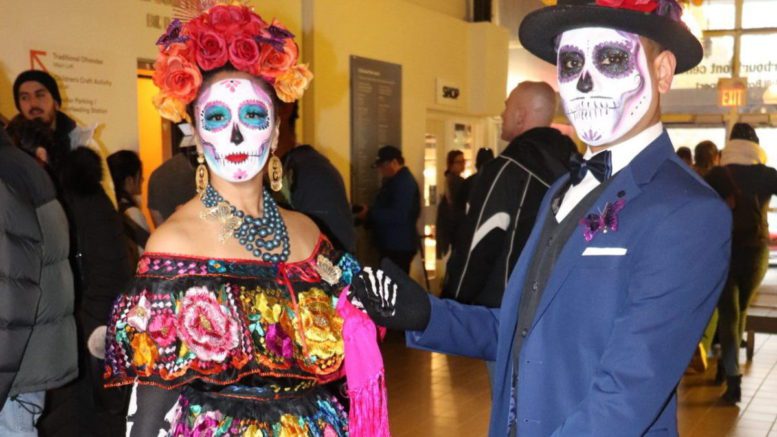A single cactus, rooted in sand, stands in the centre of the room. A hat hangs from its tip, accompanied by a gold chain, and a small photograph sits on the floor beside it. The piece, created by Erick Garcia Gomez is an altar, also known as an ofrenda in the Mexican language, and is used during the celebration of the Day of the Dead to guide those who are no longer living back to the earth once more, in order to reconnect with loved ones.
Gomez’s altar, named “The Sand That Sweeps the Soul That Stands,” honours the migrants who lost their lives trying to cross the American border. Gomez says it was important to him to honour these people,
“Many of them don’t have an identity, they don’t have a name. These people walk in the dessert and they are illegal. But they have one place to come every year,” the artist said, pointing to his display.
Gomez, who was born in Mexico, is a long way from home but events like these remind him of a familiar celebration he holds near to his heart.
The Day of the Dead, also known as Dia De Los Muertos takes place each year on Nov. 2. The Harbourfront Centre celebrated its 16th anniversary of hosting the event, offering guests the chance to learn about traditional practises, music, fashion, yummy food, and Mexican culture, all free of charge.
This year, the centre focused on altars, and how each is personalized to its specific owner. Artists, including Gomez, displayed traditional and contemporary altars, accompanied with personal belongings, treasured objects and lit candles, which are all used to guide the spirits of the deceased back to earth. Gomez, is happy to see the Mexican tradition become increasingly popular in Western culture,
“For the Mexicans, the Day Of The Dead is very important for remembering family that passes away or people we know,” Gomez said. “It’s very important for me to have an altar because they need to come back.”
After Disney’s 2018 release of Coco, an animated film that follows a Mexican family’s experience during The Day of the Dead, the holiday has become increasingly popular in western culture. But some are still unaware of its significant traditional roots.
“You need the history of these traditions to participate,” the artist said, urging guests to educate themselves before attempting to celebrate the traditional holiday.
Much of that history was available at the Harbourfront event, including engaging and exciting information sessions on food, style, traditions and Mexican culture.
In the arts and crafts room, Juan Pablo and his two young daughters paint sugar skulls, an offering and way of honouring the departed in Mexican culture. Pablo immigrated from Mexico 15 years ago, before his daughters were born and says it’s important for him to pass the culture on to his children,
“I bring them here every year, for the last four years so they can learn and see how beautiful their culture is,” the father of two said.

